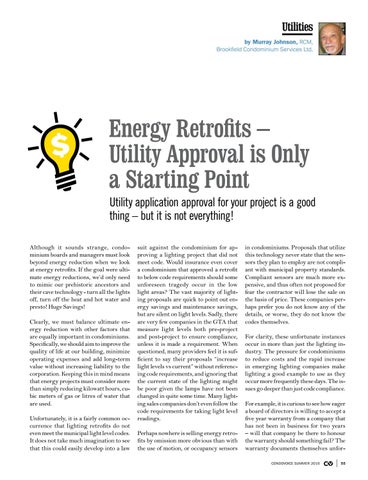Utilities by Murray Johnson, RCM, Brookfield Condominium Services Ltd.
$
Energy Retrofits – Utility Approval is Only a Starting Point Utility application approval for your project is a good thing – but it is not everything!
Although it sounds strange, condominium boards and managers must look beyond energy reduction when we look at energy retrofits. If the goal were ultimate energy reductions, we’d only need to mimic our prehistoric ancestors and their cave technology - turn all the lights off, turn off the heat and hot water and presto! Huge Savings! Clearly, we must balance ultimate energy reduction with other factors that are equally important in condominiums. Specifically, we should aim to improve the quality of life at our building, minimize operating expenses and add long-term value without increasing liability to the corporation. Keeping this in mind means that energy projects must consider more than simply reducing kilowatt hours, cubic meters of gas or litres of water that are used. Unfortunately, it is a fairly common occurrence that lighting retrofits do not even meet the municipal light level codes. It does not take much imagination to see that this could easily develop into a law
suit against the condominium for approving a lighting project that did not meet code. Would insurance even cover a condominium that approved a retrofit to below code requirements should some unforeseen tragedy occur in the low light areas? The vast majority of lighting proposals are quick to point out energy savings and maintenance savings, but are silent on light levels. Sadly, there are very few companies in the GTA that measure light levels both pre-project and post-project to ensure compliance, unless it is made a requirement. When questioned, many providers feel it is sufficient to say their proposals “increase light levels vs current” without referencing code requirements, and ignoring that the current state of the lighting might be poor given the lamps have not been changed in quite some time. Many lighting sales companies don’t even follow the code requirements for taking light level readings. Perhaps nowhere is selling energy retrofits by omission more obvious than with the use of motion, or occupancy sensors
in condominiums. Proposals that utilize this technology never state that the sensors they plan to employ are not compliant with municipal property standards. Compliant sensors are much more expensive, and thus often not proposed for fear the contractor will lose the sale on the basis of price. These companies perhaps prefer you do not know any of the details, or worse, they do not know the codes themselves. For clarity, these unfortunate instances occur in more than just the lighting industry. The pressure for condominiums to reduce costs and the rapid increase in emerging lighting companies make lighting a good example to use as they occur more frequently these days. The issues go deeper than just code compliance. For example, it is curious to see how eager a board of directors is willing to accept a five year warranty from a company that has not been in business for two years – will that company be there to honour the warranty should something fail? The warranty documents themselves unforCONDOVOICE SUMMER 2016
CV
55
